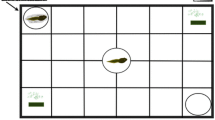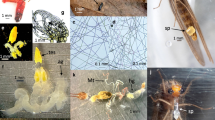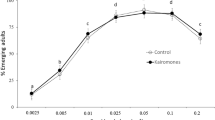Summary
The dragonfly nymph Mesogomphus lineatus satiated predating 21 larvae of Culex fatigans in 50 minutes; number of attack and predatory efficiency decreased precipitously from 2 attacks/min and 70% during the first 10 minutes of feeding to 0.04 attack/min and 0.01% efficiency respectively during the sixth 10 minutes interval. The nymphs fed after 6, 12, 18, 24, 36 or 42 hours of deprivation consumed 4, 13, 15, 20, 21 or 21 larvae; apparently, the maximum appetite is returned after about 36 hours of deprivation. Satiation time, which was 50 minutes at the density of 15 larvae/aquarium, decreased to 30 minutes in aquaria containing 200 larvae. The nymphs predated increased the number of prey when they were exposed to higher densities of C. fatigans and Anopheles stephansi larvae, and pupa of C. fatigans. They consumed equal weight (but different number) of Culex and Anopheles larvae at all the tested prey densities and selectively selected Culex larva over the pupa or Anopheles larva. Comparative analyses suggest that the dragonfly nymphs deserve serious consideration as larvivorous predators.
Similar content being viewed by others
References
Bates, M. 1965. The Natural History of Mosquitoes. Harper & Row, New York.
Beukema, J. J. 1968. Predation by three-spined stickleback (Gasterosteus aculeatus L.): The influence of hunger and experience. Behaviour 31: 1–126.
Brett, J. R. 1971. Satiation time, appetite, and maximum food intake of sockeye salmon (Oncorhynchus nerka). J. Fish. Res. Bd. Canada 28: 409–415.
Brett, J. R. & Higgs, D. A. 1970. Effect of temperature on the rate of gastric digestion of fingerling sockeye salmon, Oncorhynchus nerka, J. Fish. Res. Bd. Canada 27: 1767–1779.
Chiszar, D. & Windell, J. T. 1973. Predation by bluegill sunfish (Lepomis macrochirus rafinesque) upon mealworm larvae (Tenebrio molitor). Anim. Behav. 21: 536–543.
Christophers, S. R. 1960. Aedes aegypti (L): The Yellow Fever Mosquito. Cambridge Univ. Press, London.
Ellis, R. A. & Borden, J. H. 1970. Predation by Notonecta undulata (Heteroptera: Notonectidae) on larvae of the Yellow-Fever Mosquito. Ann. Entomol. Soc. Amer. 63: 963–973.
Grover, K. K. & Pillay, M. K. K. 1970. The mating ability of males of Culex pipines fatigans Wiedmann, sterilized with apholate or tepa. Bull Wld. Hlth. Org. 42: 808–815.
Hati, A. K. & Ghosh, S. M. 1965. Laboratory studies on the predaceous habits of the dragonfly nymph (Brachytron pratenuse): diptera prey. Bull. Calcutta Sch. Trop. Med. 13: 61–62.
Hinman, E. H. 1934. Predators of the Culicidae (mosquitoes). I. The predators of the larvae and pupae, exclusive of fish. J. Trop. Med. Hyg. 37: 145–150.
Holling, C. S. 1966. The functional response of invertebrate predators to prey density. Mem. Entomol. Soc. Can. 48: 1–86.
James, H. G. 1964. Insect and other fauna associated with the rock pool mosquito Aedes atropalpus (Cog.). Mosquito News 24: 155–159.
Kleerekoper, H. & Mogensen, J. 1963. Role of olfaction in the orientation of Petromyzon marinus. I. Response to a single amine in prey's body odor. Physiol. Zool. 36: 347–360.
Mayr, J. 1955. Regulation of energy intake and the body weight: the glucostatic theory and the lipostatic hypothesis. Ann. N.Y. Acad. Sci. 63: 15–43.
Miner, R. W. 1955. Regulation of hunger and appetite. Ann. N.Y. Acad. Sci. 63: 1–144.
Omardeen, T. A. 1957. The behaviour of larvae and pupae of Aedes aegypti (L) in light and temperature gradients. Bull. Ent. Res. 48: 349–357.
Pandian, T. J. 1967. Intake, digestion, absorption and conversion of food in the fishes Megalops cyprinoides and Ophiocephalus striatus. Mar. Biol. 1: 16–32.
Pandian, T. J. 1974. Mechanisms of heterotrophy. In Kinne, O., ed., Marine Ecology. Vol 2 Part I pp. 61–249, Wiley, London.
Pritchard, G. 1965. Prey capture by dragonfly larvae (Odonata: Anisoptera). Can. J. Zool. 43: 785–800.
Rashesky, N. 1959. Some remarks on the mathematical theory of nutrition of fishes. Bull. Math. Biophys. 21: 161–183.
Reddy, S. R. 1973. Mosquito control through larvivorous predators. Ph. D. thesis submitted to Bangalore University, Bangalore.
Reddy, S. R. & Pandian, T. J. 1974. Effect of water current on the predatory efficiency of Gambusia affinis. Oecologia 16: 253–256.
Ruitner, L. de. 1963. The physiology of vertebrate behaviour towards a synthesis of the ethological and physiological approaches to problems of behaviour. Z. Tierphysiol. Tierenahr. Futtermittelk. 20: 498–516.
Sailer, R. I. & Lienk, S. E. 1954, Insect predators of mosquito larvae and pupae in Alaska. Mosquito News. 14: 14–16.
Service, M. W. 1965. Tacharomia sp. as predators of adult anopheline mosquitoes. WHO/ FBL/65: 1–4.
Ware, D. M. 1972. Predation by rainbow trout (Salmo gairdneri): the influence of hunger, prey density, and prey size. J. Fish. Res. Bd. Canada 29: 1193–1202.
Windell, J. T. 1967. Rates of digestion in fishes. In Gerking S.D.,ed., Biological Basis of Freshwater Fish Production. pp. 151–173. Blackwell Scientific Publications, Oxford.
Young, A. M. 1967. Predation in the larvae of Dytiscus marginalis (L) (Coleoptera: Dytiscidae). Pan-Pac. Entomol. 43: 113–117.
Author information
Authors and Affiliations
Rights and permissions
About this article
Cite this article
Mathavan, S. Satiation time and predatory behaviour of the dragonfly nymph Mesogomphus lineatus. Hydrobiologia 50, 55–64 (1976). https://doi.org/10.1007/BF00016841
Received:
Published:
Issue Date:
DOI: https://doi.org/10.1007/BF00016841




